Preparation Method of Similar Materials for the Progressive Disintegration of Red-Bedded Soft Rock Based on Diagenesis Simulation
Abstract
1. Introduction
2. Mechanisms of the Progressive Disintegration of Red-Bedded Soft Rock
- 1.
- Cement dissolution resulting in the detachment of solid particles.
- 2.
- Non-uniform solid particle expansion due to water absorption after immersion.
- 3.
- Pneumatic cracking of soft rocks occurs as water enters the pores of the rock and compresses the air in the sealed pores after immersion.
- 4.
- Cement dissolution, which undermines the mineral cementation of the rock, progresses more rapidly, and remains dissolved as long as the solution does not reach the saturation state of the corresponding ion. Thus, adequate water immersion does not lead to progressive disintegration via cement dissolution.
- 5.
- Non-uniform swelling of particles by immersion in water disrupts cementation and mineral particle bonding; however, a single non-uniform swelling event only slightly opens the cementation; therefore, multiple iterations of non-uniform swelling are required for cracking to occur, necessitating repeated dry soaking to break tightly cemented bonds.
- 6.
- Gas-induced collapse, illustrated in Figure 2, is the primary contributor to red-bedded soft rock disintegration.
- 7.
- Cementation between mineral grains.
- 8.
- Embedded solidification. The disintegration of clay cement is the primary cause of soft rock disintegration. However, the disintegration of many red-bed soft rocks does not occur instantaneously; instead, it occurs progressively with dry–wet cycles, resulting in progressive disintegration.
3. Sample Preparation
3.1. Sample Materials and Sample Preparation Systems
- Sodium chloride
- Montmorillonite particles (800 mesh)
- STGP (with a melting point of 450 °C and a particle size of 800 mesh)
- Quartz sand (a mixture of various particle sizes, including 40–70 mesh (35%), 70–110 mesh (10%), 110–200 mesh (20%), and 200–300 mesh (35%)).
- Loading device: jack loading range of 0–125 MPa, with a piston rod diameter of 50 mm;
- Heating device: high-temperature furnace with a heating range from room temperature to 800 °C and an accuracy of ±1 °C;
- Sample-making mold: inner diameter of 50 mm, accuracy of ±0.01 mm, and height of 160 mm.
3.2. Orthogonal Design Test Protocol
3.3. Specimen Preparation Procedure and Test Content
4. Test Results and Analysis
4.1. Progressive Disintegration Properties of Similar Materials
4.1.1. Similar Material Disintegration Test by Immersion in Water
4.1.2. Disintegration Resistance Test for Similar Materials
4.2. Physical and Mechanical Properties of Similar Materials

4.3. Microstructure of Similar Materials
5. Conclusions
- 9.
- The dynamic and static disintegration processes of similar material specimens indicate that incorporating STGP is feasible for preparing a similar material with a disintegration process similar to that of natural rock samples. A similar material can simulate the disintegration process of a natural red-bedded soft rock well.
- 10.
- Mixing STGP increased the density, compressive strength, and elastic modulus of similar material specimens while reducing the porosity ratio. The experiments demonstrated that similar materials made in the presented study have similar basic physical and mechanical properties compared with core red-bedded soft samples when the contents of STGP are 0.5–2%.
- 11.
- The STGP content was identified as the key factor affecting the physical and mechanical properties and disintegration process of similar materials, based on the analysis of the physical and mechanical test results of similar materials in the experimental group.
- 12.
- Scanning electron microscopic observations of specimens with different STGP content levels showed that the higher the STGP content, the smaller the particle spacing between the aggregates of similar material specimens, indicating that incorporating STGP can promote the formation of particles embedded in similar materials and result in the progressive disintegration of similar materials.
Author Contributions
Funding
Data Availability Statement
Conflicts of Interest
References
- Huang, K.; Kang, B.; Zha, F.; Li, Y.; Zhang, Q.; Chu, C. Disintegration characteristics and mechanism of red-bed argillaceous siltstone under drying–wetting cycle. Environ. Earth Sci. 2022, 81, 336. [Google Scholar] [CrossRef]
- Wang, R.; Zheng, M.; Ao, B.; Liu, H.; Cheng, P. Disintegration Characteristics Investigation of Carbonaceous Shale in High-Latitude Cold Regions. Buildings 2023, 13, 466. [Google Scholar] [CrossRef]
- Yu, F.; Tong, K.; Fu, Z.; Feng, G.; Zhou, Z.; Chen, S.; Dai, Z. Multi-scale deformation characteristics and mechanism of red-bed mudstone in dry-wet environment. Front. Earth Sci. 2022, 10, 974707. [Google Scholar] [CrossRef]
- Yao, H.; Jia, S.; Gan, W.; Zhang, Z.; Lu, K. Properties of Crushed Red-Bed Soft Rock Mixtures Used in Subgrade. Adv. Mater. Sci. Eng. 2016, 2016, 9624974. [Google Scholar] [CrossRef]
- Zhang, X.; Geng, J.; Xu, Y.; Zhou, Z.; Pang, S.; Černý, R. Research on Soft Rocks for the Construction of Roadbeds for High-Speed Railroad: Effect of Water Soaking Environment. Adv. Mater. Sci. Eng. 2022, 2022, 7070119. [Google Scholar] [CrossRef]
- Xie, X.; Su, D.; Li, X.; Hu, H. Research on Red-Bed Soft Rock Engineering Properties and Foundation Appraisement of Construction Engineering in Guangzhou. Environ. Earth Sci 2021, 768, 012162. [Google Scholar] [CrossRef]
- Fu, H.; Qi, S.; Shi, Z.; Zeng, L. Mixing Ratios and Cementing Mechanism of Similar Silty Mudstone Materials for Model Tests. Adv. Civ. Eng. 2021, 2021, 2426130. [Google Scholar] [CrossRef]
- Cui, G.; Zhou, C.; Liu, Z.; Xia, C.; Zhang, L. The synthesis of soft rocks based on physical and mechanical properties of red mudstone. Int. J. Rock Mech. Min. Sci. 2022, 151, 105037. [Google Scholar] [CrossRef]
- Li, S.; Wang, H.; Zhang, Q.; Li, Y. New Type Geo-Mechanical Similar Material Experiments Research and Its Application. Key Eng. Mater. 2006, 326–328, 1801–1804. [Google Scholar] [CrossRef]
- Li, J.; Wu, Y.; Wang, Y.; Qin, N.; Wang, W. Experimental Study on Self-Made Similar Material of Soft Rock. Key Eng. Mater. 2016, 717, 140–146. [Google Scholar] [CrossRef]
- Lu, H.; Zhang, K.; Yi, J.; Wei, A. A study on the optimal selection of similar materials for the physical simulation experiment based on rock mineral components. Eng. Fail. Anal. 2022, 140, 106607. [Google Scholar]
- Guo, Y.; Cao, R.; Zhu, L. Research on Similar Material in Physical Specimen Petrography of Rock. Adv. Mater. Res. 2012, 616–618, 346–349. [Google Scholar] [CrossRef]
- Diao, X.; Wang, K.; Fu, P. Study on Proportioning of Similar Material to Swelling Rock. Appl. Mech. Mater. 2014, 501–504, 439–443. [Google Scholar] [CrossRef]
- Zhou, C.; Kong, L.; Cui, G.; Yu, L.; Liu, Z. Molding simulation of soft rock based on natural red bed materials. Rock Soil Mech. 2020, 41, 419–427. [Google Scholar]
- Yang, P.; Zhang, L.; Liu, K.; Cao, B.; Gao, J.; Qiu, G. Diagenetic history and reservoir evolution of tight sandstones in the second member of the Upper Triassic Xujiahe Formation, western Sichuan Basin, China. J. Pet. Sci. Eng. 2021, 201, 108451. [Google Scholar] [CrossRef]
- Luo, L.; Meng, W.; Gluyas, J.; Tan, X.; Gao, X.; Feng, M.; Kong, X.; Shao, H. Diagenetic characteristics, evolution, controlling factors of diagenetic system and their impacts on reservoir quality in tight deltaic sandstones: Typical example from the Xujiahe Formation in Western Sichuan Foreland Basin, SW China. Mar. Pet. Geol. 2019, 103, 231–254. [Google Scholar] [CrossRef]
- Niemeijer, A.R.; Spiers, C.J.; Bos, B. Compaction creep of quartz sand at 400~600 °C: Experimental evidence for dissolution-controlled pressure solution. Earth Planet. Sci. Lett. 2001, 195, 261–275. [Google Scholar] [CrossRef]
- Wong, L.N.Y.; Maruvanchery, V.; Liu, G. Water effects on rock strength and stiffness degradation. Acta Geotech. 2016, 11, 713–737. [Google Scholar] [CrossRef]
- Liu, X. Research on Slaking Properties of Red Beds Soft Rock and Dynamic Deformation Properties of Embankment. Doctor’s Thesis. Hunan University, Changsha, Chian, 2006. (In Chinese). [Google Scholar]
- Moriwaki, Y. Causes of Slaking in Argillaceous Materials. Doctor’s Thesis. University of California, Berkeley, CA, USA, 1974. [Google Scholar]
- Zha, F.; Huang, K.; Kang, B.; Sun, X.; Su, J.; Li, Y.; Lu, Z. Deterioration Characteristic and Constitutive Model of Red-Bed Argillaceous Siltstone Subjected to Drying-Wetting Cycles. Lithosphere 2022, 2022, 8786210. [Google Scholar] [CrossRef]
- England, P.C.; Thompson, A.B. Pressure-Temperature-Time Paths of Regional Metamorphism I. Heat Transfer during the Evolution of Regions of Thickened Continental Crust. J. Petrol. 1984, 25, 894–928. [Google Scholar] [CrossRef]
- England, P.C.; Thompson, A.B. Pressure-Temperature-Time Paths of Regional Metamorphism II. Their Inference and Interpretation using Mineral Assemblages in Metamorphic Rocks. J. Petrol. 1984, 25, 929–955. [Google Scholar]
- Bevins, E.R.; Robinson, D. Low-grade metamorphism. Geol. Today 1992, 8, 23–27. [Google Scholar] [CrossRef]
- Lu, J.; Wang, G.; Wang, H.; Chen, H.; Wu, C. Metamorphic P-T-t paths retrieved from the amphibolites, Lushan terrane, Henan Province and reappraisal of the Paleoproterozoic tectonic evolution of the Trans-North China Orogen. Precambrian Res. 2013, 238, 61–77. [Google Scholar] [CrossRef]
- De Segonzac, G.D. The Transformation of Clay Minerals during Diagenesis and Low-Grade Metamorphism: A Review. Sedimentology 1970, 15, 281–346. [Google Scholar] [CrossRef]
- Gluyas, J.; Cade, A.C.; Kupecz, A.J.; Gluyas, J.; Bloch, S. Prediction of Porosity in Compacted Sands. Reserv. Qual. Predict. Sandstones Carbonates 1997, 69, 19–27. [Google Scholar]
- Ministry of Housing and Urban-Rural Development of the People’s Republic of China. Standard for Engineering Rock Test Methods, 2nd ed.; China Planning Press: Beijing, China, 2013; pp. 154–196. (In Chinese) [Google Scholar]


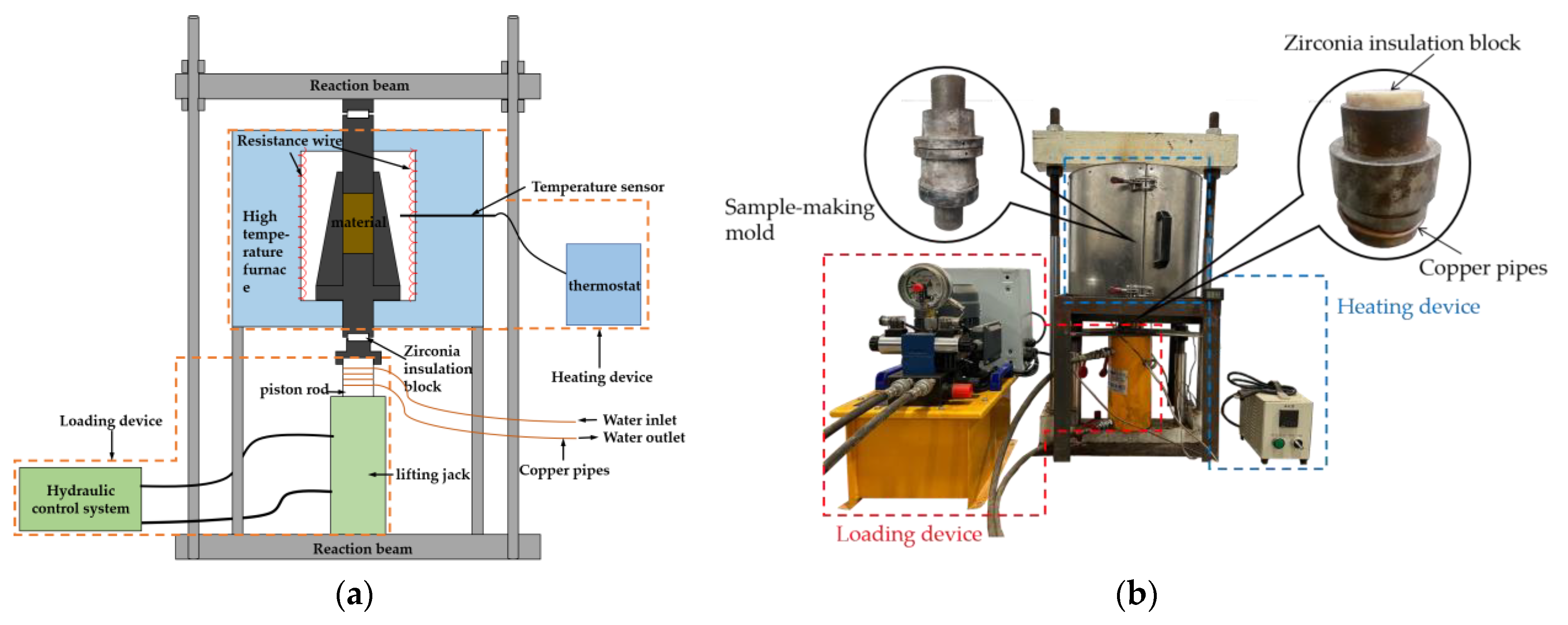
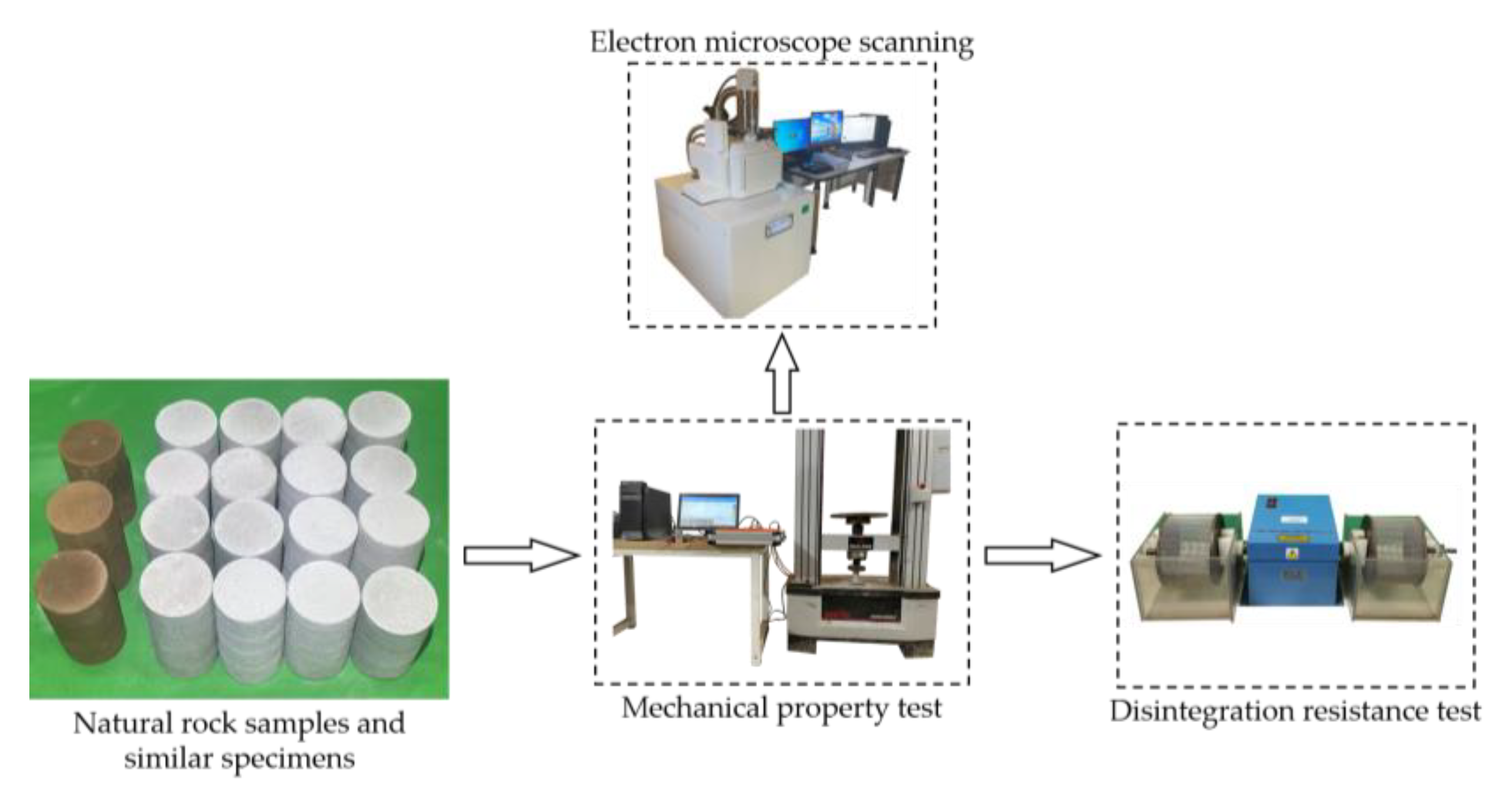
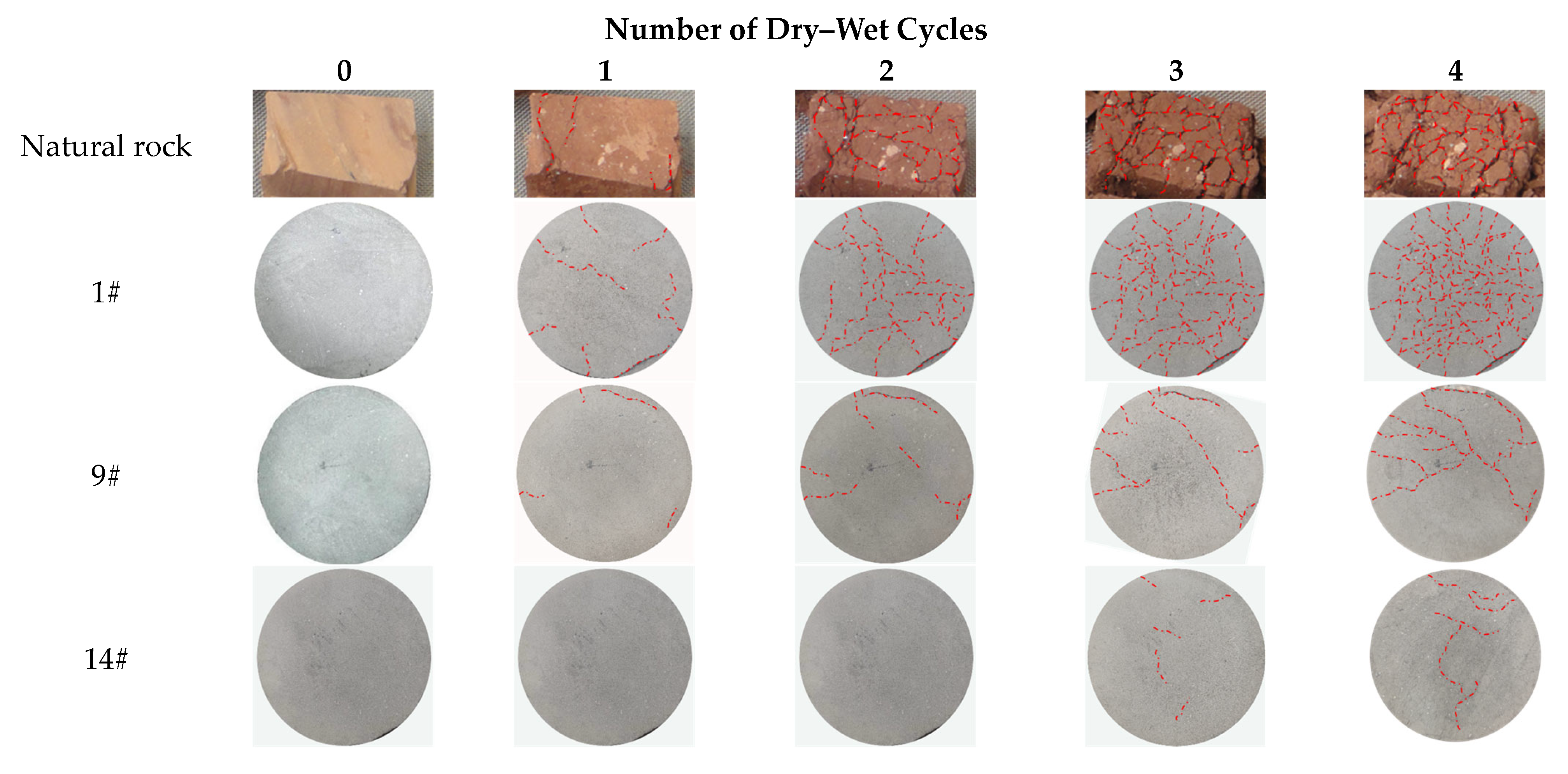
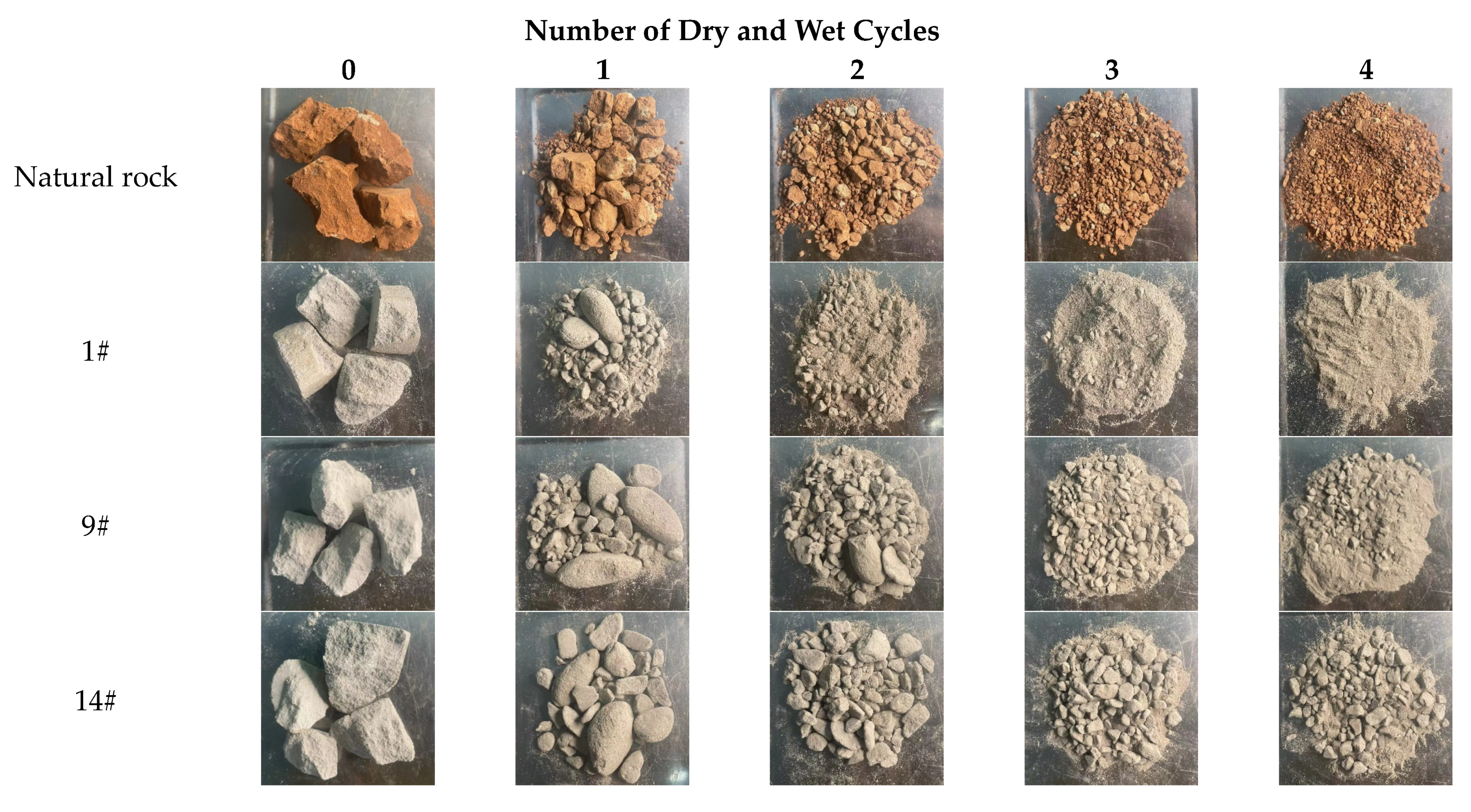
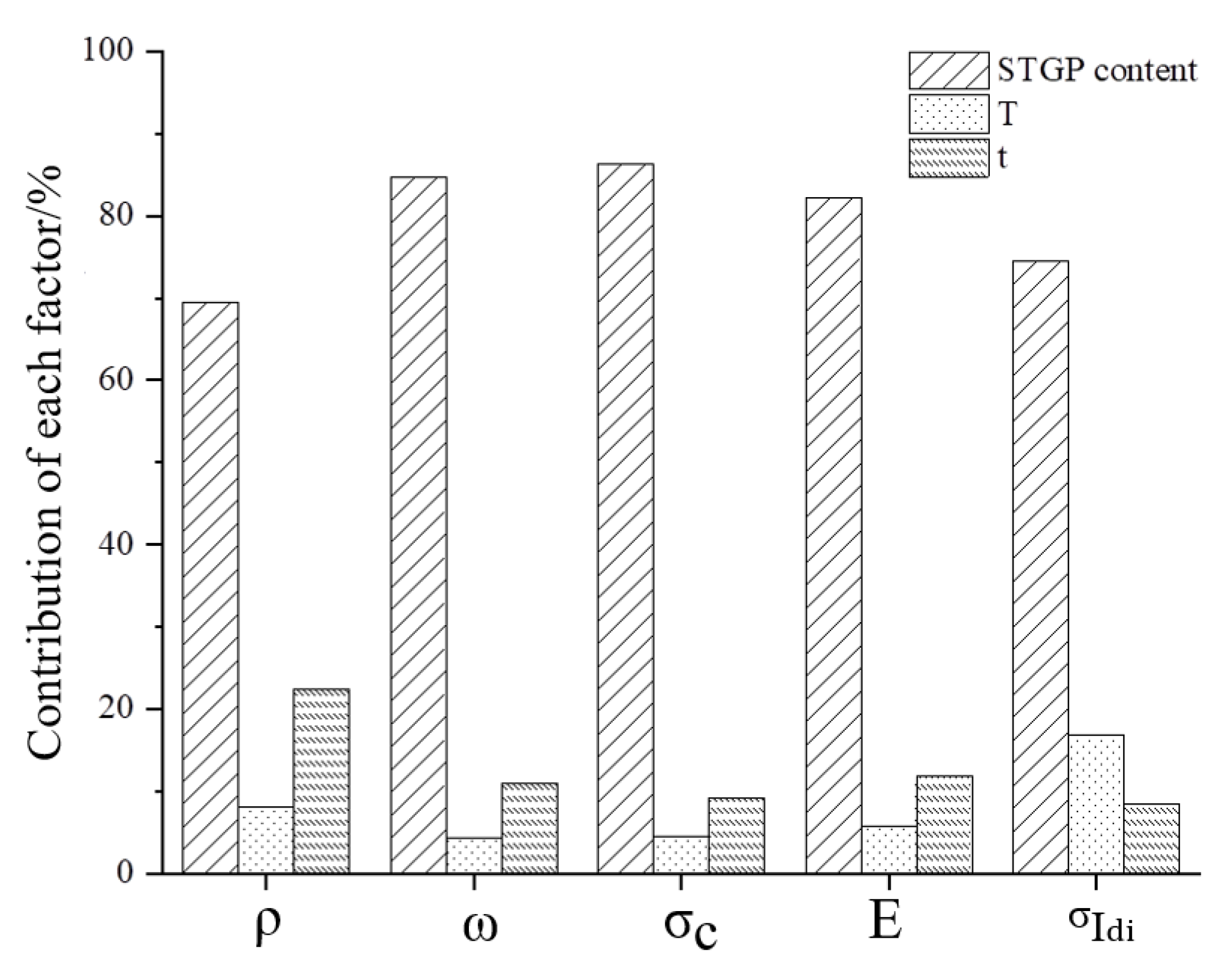
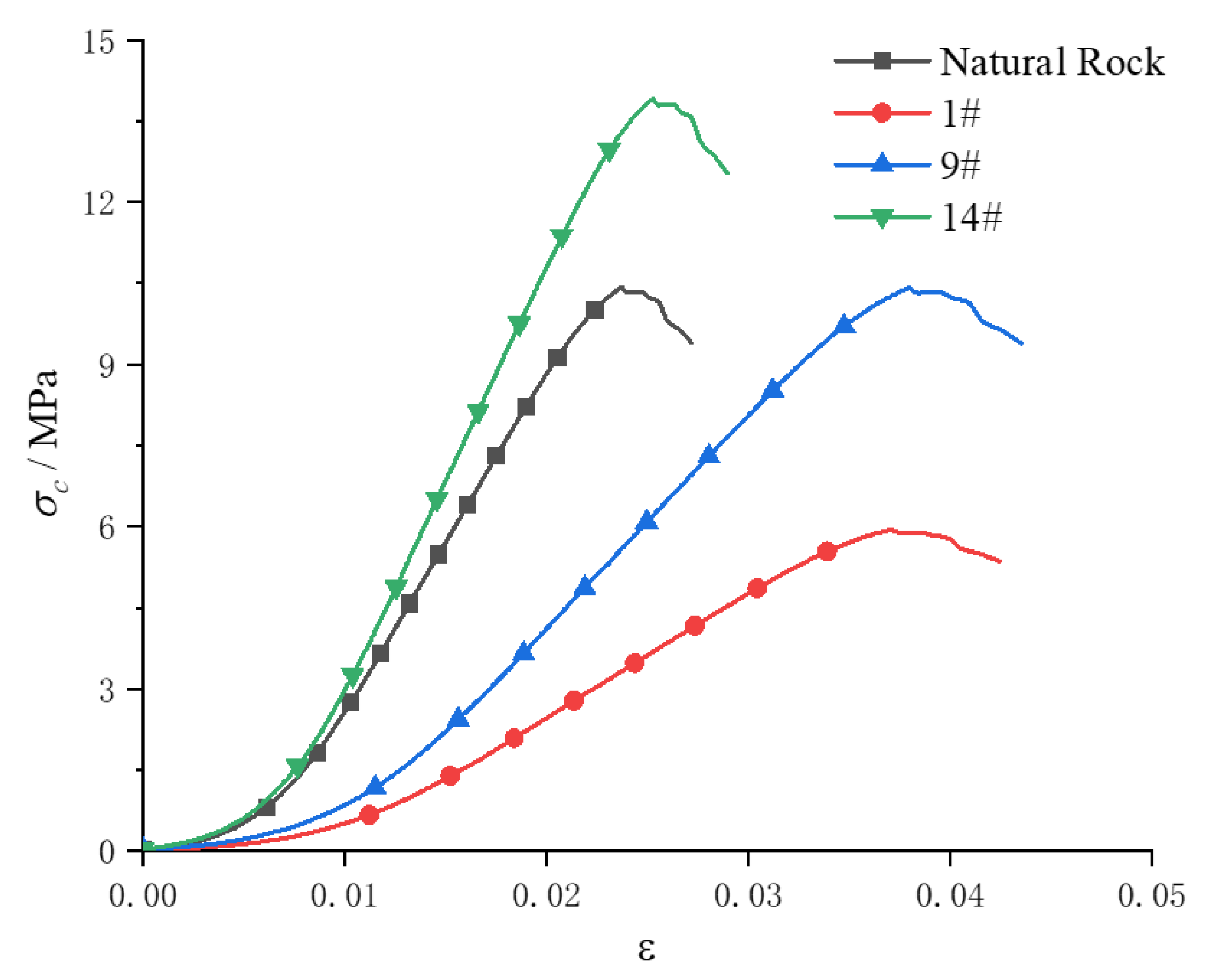
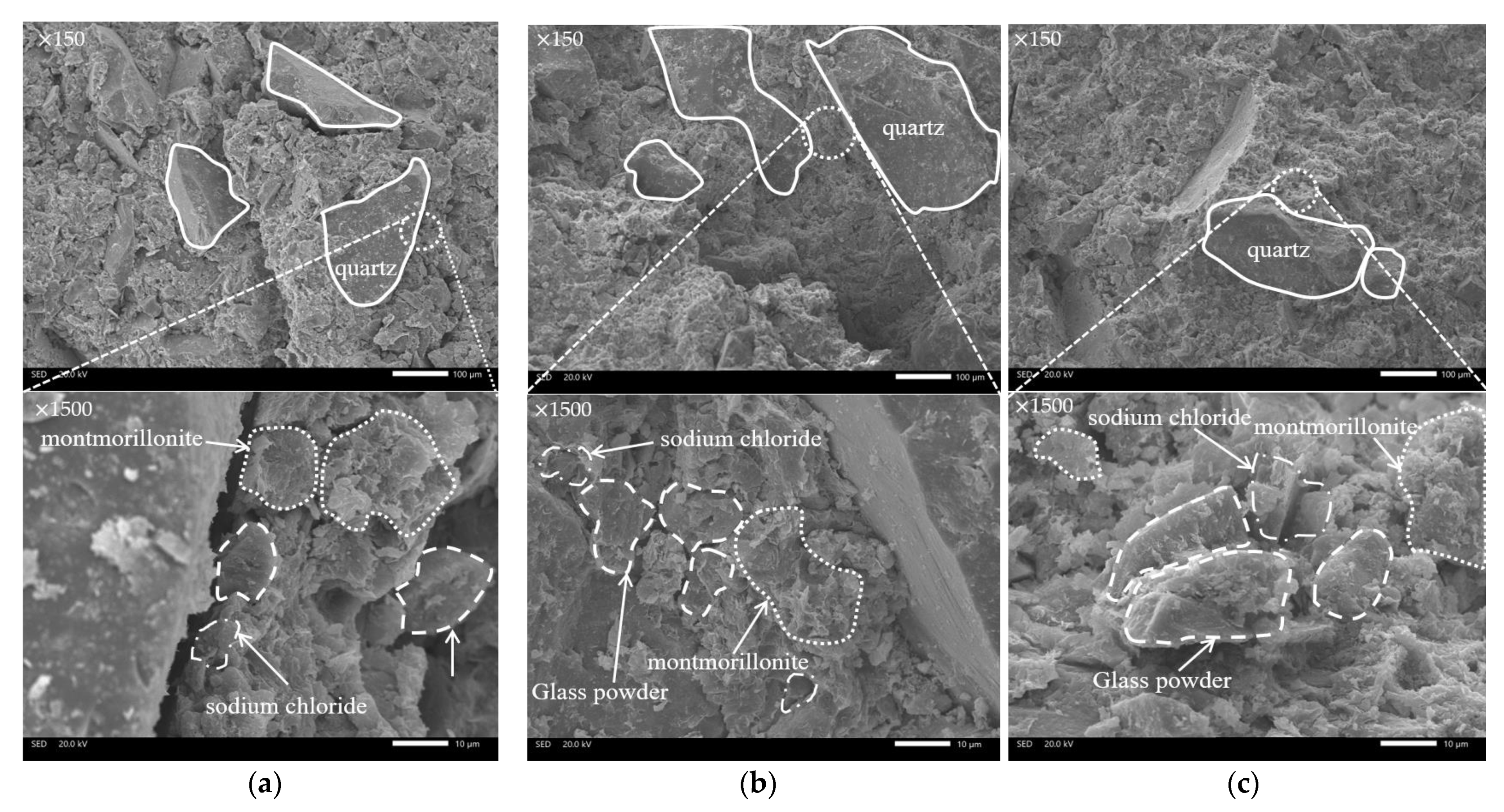
| ρ/(g · cm−3) | ω/(%) | E/(MPa) | |
|---|---|---|---|
| 2.14 | 16.2 | 10.41 | 372.51 |
| Mineral Composition | Quartz | Feldspar | Mica | Hematite | Montmorillonite | Chlorite |
|---|---|---|---|---|---|---|
| Mass ratio/(%) | 29.5 | 9.6 | 9.1 | 2.7 | 42.7 | 6.4 |
| Grain size/(μm) | ~15.63 | ~74.33 | ~148.7 | ~210.2 | ~353.6 |
| Cumulative Percentage/(%) | 51.42 | 69.32 | 81.18 | 89.29 | 100 |
| Material | STGP | Quartz | Montmorillonite | Sodium Chloride |
|---|---|---|---|---|
| Mass ratio/% | 0.5~5 | 35~39.5 | 50 | 10 |
| Experiment No. | STGP Content/(%) | Temperature/(°C) | Pressing Duration/(h) |
|---|---|---|---|
| 1 | 0.5 | 450 | 12 |
| 2 | 0.5 | 500 | 24 |
| 3 | 0.5 | 550 | 36 |
| 4 | 0.5 | 600 | 48 |
| 5 | 1 | 450 | 24 |
| 6 | 1 | 500 | 12 |
| 7 | 1 | 550 | 48 |
| 8 | 1 | 600 | 36 |
| 9 | 2 | 450 | 36 |
| 10 | 2 | 500 | 48 |
| 11 | 2 | 550 | 12 |
| 12 | 2 | 600 | 24 |
| 13 | 5 | 450 | 48 |
| 14 | 5 | 500 | 36 |
| 15 | 5 | 550 | 24 |
| 16 | 5 | 600 | 12 |
| Experiment No. | ρ/(g · cm−3) | ||||
|---|---|---|---|---|---|
| 1 | 1.54 | 19.3 | 5.9 | 237.87 | 51.59 |
| 2 | 1.62 | 18.2 | 7.1 | 278.12 | 44.15 |
| 3 | 1.67 | 17.7 | 8.5 | 325.07 | 30.57 |
| 4 | 1.74 | 17.6 | 8.3 | 318.36 | 40.46 |
| 5 | 1.62 | 18.1 | 7.3 | 284.82 | 38.62 |
| 6 | 1.61 | 17.9 | 8 | 308.3 | 39.64 |
| 7 | 1.78 | 16.9 | 9.1 | 345.19 | 14.78 |
| 8 | 1.8 | 16.5 | 9.9 | 372.02 | 9.70 |
| 9 | 1.82 | 16.2 | 10.4 | 388.79 | 3.57 |
| 10 | 1.85 | 15 | 11.2 | 415.62 | 2.28 |
| 11 | 1.73 | 16.6 | 9.8 | 368.67 | 15.48 |
| 12 | 1.85 | 14.9 | 11.9 | 439.09 | 4.50 |
| 13 | 1.89 | 14.2 | 13.1 | 449.34 | 25.76 |
| 14 | 1.93 | 13.9 | 13.9 | 476.17 | 31.21 |
| 15 | 1.89 | 14.4 | 12.8 | 439.28 | 23.4 |
| 16 | 1.84 | 15.3 | 11.9 | 409.09 | 7.58 |
Disclaimer/Publisher’s Note: The statements, opinions and data contained in all publications are solely those of the individual author(s) and contributor(s) and not of MDPI and/or the editor(s). MDPI and/or the editor(s) disclaim responsibility for any injury to people or property resulting from any ideas, methods, instructions or products referred to in the content. |
© 2023 by the authors. Licensee MDPI, Basel, Switzerland. This article is an open access article distributed under the terms and conditions of the Creative Commons Attribution (CC BY) license (https://creativecommons.org/licenses/by/4.0/).
Share and Cite
Liu, X.; Jiang, D.; Jia, Q.; Xu, H.; Wang, T. Preparation Method of Similar Materials for the Progressive Disintegration of Red-Bedded Soft Rock Based on Diagenesis Simulation. Buildings 2023, 13, 875. https://doi.org/10.3390/buildings13040875
Liu X, Jiang D, Jia Q, Xu H, Wang T. Preparation Method of Similar Materials for the Progressive Disintegration of Red-Bedded Soft Rock Based on Diagenesis Simulation. Buildings. 2023; 13(4):875. https://doi.org/10.3390/buildings13040875
Chicago/Turabian StyleLiu, Xiaoming, Dongcheng Jiang, Qinji Jia, Haifeng Xu, and Tong Wang. 2023. "Preparation Method of Similar Materials for the Progressive Disintegration of Red-Bedded Soft Rock Based on Diagenesis Simulation" Buildings 13, no. 4: 875. https://doi.org/10.3390/buildings13040875
APA StyleLiu, X., Jiang, D., Jia, Q., Xu, H., & Wang, T. (2023). Preparation Method of Similar Materials for the Progressive Disintegration of Red-Bedded Soft Rock Based on Diagenesis Simulation. Buildings, 13(4), 875. https://doi.org/10.3390/buildings13040875







